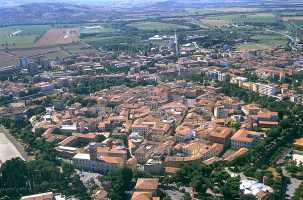Grosseto is the capital of the province of the same name in Tuscany. In terms of land area, it is the largest municipality in the region.
From an urban point of view, the city is one of the few capitals whose historic center has remained completely surrounded by a circle of walls, intact as a whole, which has kept its appearance almost unchanged over the centuries .
The city is located about 12 km from the sea (where the municipal fractions of Marina di Grosseto and Principina a Mare overlook), in the center of an alluvial plain called Maremma Grosseto, at the point of confluence of the Ombrone valley. In the past, a large part of the flat area was occupied by Lake Prile which extended almost to the western part of the city. Today it has almost completely disappeared following the canalization works included in the eighteenth-century reclamations.
In the north-eastern part of the municipal area, near the modern fraction of Roselle which arose near the ancient Etruscan-Roman city, there is a spring sulphurous water spa, of the same nature and origin that distinguishes the most renowned Terme di Saturnia and the other spas scattered between Mount Amiata, the area of Tufo and the hills of Albegna and Fiora.
The Ombrone river flows in the eastern and southern part of the municipal area.
The western part of the municipal territory is included in the Diaccia Botrona nature reserve, a marshy area which extends where the ancient Prile lake once stood, while the he south-western area is part of the Maremma natural park, where the Marshy area of the Trappola extends and the first offshoots of the Uccellina mountains south of the mouth of the Ombrone.
The municipal area also includes the Formiche di Grosseto, in the heart of the Tuscan Archipelago national park; the islets and the entire stretch of sea that laps the coast of Grosseto are also in the European protected marine area of the Sanctuary for marine mammals.
The historic center is completely enclosed within fortified walls which, at an urban level, isolate it almost completely from the rest of the city, with the exception of the Porta Nuova area where during the 19th century the city gate was demolished, the embankment of the moat was filled in and a small section of the curtain wall was knocked down.
The current historical center is the result of the sixteenth-century reconstruction of the walls, during which they assumed a larger perimeter which enlarged the surface of the historical city center with respect to the medieval urban fabric; however, the construction of the Medici walls involved the demolition of many buildings from the Middle Ages, including some religious complexes, which stood outside the pre-existing city center along the perimeter where the later arose ‘current walls with bastions of hexagonal shape. During the 19th century residential areas developed in a centrifugal sense, of which the Art Nouveau buildings can be seen along the road leading to the railway station; in the first decades of the 20th century monumental churches were built to delimit the new extension of the urban area, some in the neo-medieval style (church of San Giuseppe and church of San Giuseppe Benedetto Cottolengo), others in a modern-functionalist style (Basilica del Sacro Cuore).
Four are the large urban districts of Grosseto, the Centro district, the oldest part, and the districts of Gorarella , Barbanella and Sugherella. Despite the expansion, the urban context can be framed within a larger rural area which includes the various hamlets, which have maintained distinct territorial and urban characteristics between them and with respect to the city centre.
Grosseto is considered a very green city due to the presence of picnic areas and parks everywhere in the city. There are two large urban parks in Grosseto:
The viale Giotto park is home to over 650 plants and shrubs, as well as the Massimo Falsetti Cricket Field, a skatepark, the “Guido Montanelli” velodrome , a climbing gym and a pond inhabited by mallards.
The urban park of the Ombrone river “Silvano Signori”, also known as Ombrone park or via Leoncavallo park, is 10 hectares large and houses 750 plants and shrubs, as well as a skating rink, a square, cycle paths of 2 km and two natural lakes.
The areas equipped for children are instead thirty-seven, scattered in all quarters of the city and in the hamlets. Among these, the “Renato Pollini” playground stands out.
Monuments and places of interest
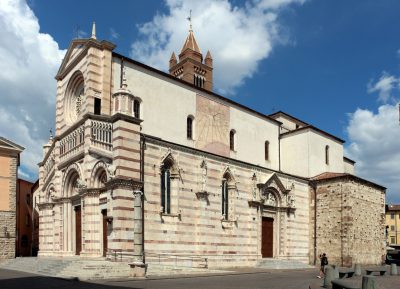
Duomo di Grosseto
•Cathedral of San Lorenzo, or Duomo di Grosseto, is located in the main square of the city and was built between 1294 and 1302 on project by the architect Sozzo di Rustichino, in the place where previously the early medieval parish church of Santa Maria once stood. Completion works were then carried out between 1330 and 1340, and finally the structure was rebuilt in the 16th century by Anton Maria Lari. Further renovations between 1840 and 1865 subsequently modified the Renaissance and Baroque appearance of the building, in an attempt to return it to primitive medieval forms. > In 2013, a marble platform was built on the right side of the church for access to the disabled. The facade is presented on the basis of the Romanesque taste for the white-red duotone (red Caldana marble) and for the gothic shapes; on it are placed the statues of the four evangelists, dating back to the fourteenth century, a beautiful central rose window with the depiction of the Redeemer, two sixteenth-century kiosks sides, a gallery with original columns, a tympanum with religious images (1897) by the artist Leopoldo Maccari. Inside there are some works, including: a fountain from 1506; a baptismal font by Antonio Ghini; the two stained glass windows made to a design by Benvenuto di Giovanni depicting the first Isaiah and Micah, the Annunciation, Saints Peter the Apostle and Jerome, Saints Catherine of Alexandria and Mary Magdalene, the second Faith and Hope, the saints Michael the Archangel, John the Baptist, Bartholomew the Apostle, Ludovico, Lorenzo and Sebastiano; a polychrome wooden crucifix from the second half of the 15th century; two angels holding candlesticks by Domenico Arrighetti; finally, the venerated Madonna delle Grazie, in the left chapel of the transept, central part of a table by Matteo di Giovanni, datable to 1470. Many of the works of art originally located in the cathedral they are preserved in the museum of sacred art of the diocese of Grosseto.
The bell tower was raised on the northern left side only in 1402, while the internal staircase was built in 1611. In 1911 it was remodeled, transforming the arched windows into mullioned windows and mullioned windows, and raised. There are sculptural fragments of the original Gothic decoration of the church.
In the cathedral there is the Mascioni pipe organ opus 775, built in 1959, during an important restoration work carried out by the manufacturer in 2004, the registers were redistributed over three manuals.
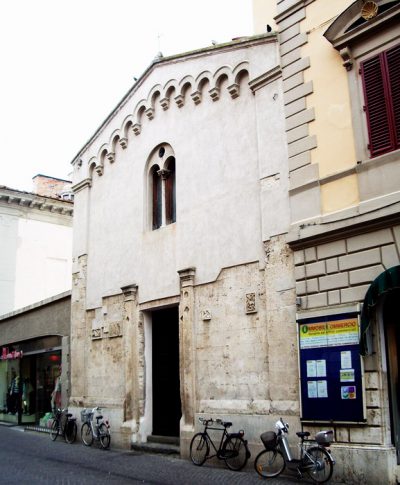
Church of San Pietro
•Church of San Pietro, located along Corso Carducci, is the oldest church in Grosseto. Originally positioned along the route of the ancient Via Aurelia – which crossed the very center of the city – it is mentioned in the bull of Clement III of 1188. Of simple and bare architectural lines, it seems to date back originally to the 8th century, even if it underwent substantial expansions between the 9th and 12th centuries and its appearance in the 21st century is partly due to some 17th and 18th century restorations, while the bell tower was erected in 1625. On the façade, next to the pilasters that delimit the portal, there are four bas-reliefs (two on each side), dating from between the Byzantine period and the early Middle Ages: one bas-relief depicts vegetable elements, a human figure is carved on another, while the other two are characterized by a series of animals.
The church of San Pietro is characterized by the Romanesque-style apse with a characteristic semicircular shape; the external walls are in stone, where some travertine blocks are clearly visible, breaking up the primary cladding at times. The seventeenth-century brick belltower rises to the right of the apse area, resting on a stone base that probably dates back to the Middle Ages; at the top of the bell tower rises a small dome.
The interior of the church has a single nave, with the original Romanesque stylistic elements now lost, following various renovations that have taken place over the centuries.
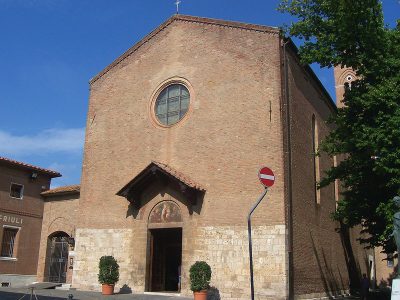
Church of San Francesco
•Church of San Francesco, located in the square of the same name in the historic centre, was consecrated in 1289 when the Franciscans took possession, following of the rebuilding of the building on the site of an older church dedicated to San Fortunato and belonging to the Benedictines, who abandoned it in 1230. Subsequent restructuring works partly The original appearance was modified and at the beginning of the 20th century the bell tower was rebuilt, raised by one floor, damaged by lightning in 1917.
On the facade there is a small rose window and above the portal a lunette with a fresco by Giuseppe Casucci depicting the saints Francis of Assisi and Lorenzo .
Inside, among the various works, the 13th-century wooden Crucifix stands out above all, with dubious attribution, oscillating between Duccio di Buoninsegna, the Master of Badia in Isola and Guido di Graziano. Leaning against the left side of the church is the convent with cloister, characterized by the presence of the sixteenth century Bufala well.
The chapel on the right, dedicated to Sant’Antonio, was added during the 17th century anddecorated with valuable frescoes by the painters Antonio and Francesco Nasini.
•Piazza Dante, the main city square, also known as Piazza delle Catene, was built in a trapezoidal shape between the 13th and 14th centuries. It has always been the heart of the civil and religious life of the city, the monument to Canapone is located in the centre; the cathedral, the Palazzo Comunale, Palazzo Aldobrandeschi (seat of the province) overlook it. The southern and western sides are characterized by a series of buildings that are articulated above a common loggia-portico, which develops in an L shape without solutions of continuity. At the right corner of the facade of the cathedral the presence of the column of announcements stands out.
•Palazzo Aldobrandeschi, also known as Palazzo della Provincia, is located in Piazza Dante and was built starting from 5 April 1900, after the demolition of the previous Palazzo Pretorio, which took place in the autumn of the previous year . The project was carried out by the architect Lorenzo Porciatti, with some modifications made during works in progress by Guglielmo Calderini. The building, in neo-Gothic style which recalls the stylistic elements of the Sienese Middle Ages, was inaugurated on 31 May 1903 and has since housed the< strong> seat of the Province of Grosseto.
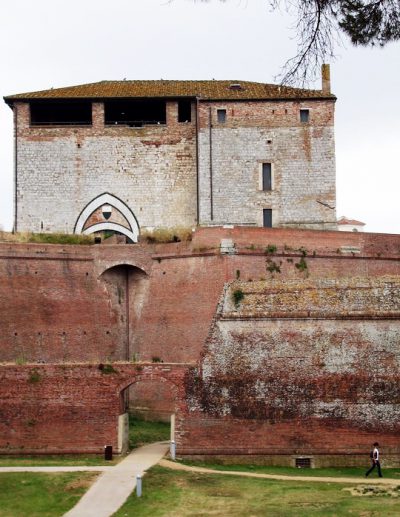
Walls of Grosseto
•Walls of Grosseto: the wall perimeter of the city of Grosseto is one of the rare examples in Italy of city walls which have survived almost intact up to the present day . The primitive walls to defend the city were built in the 12th century, but they were soon demolished by the Sienese when they took possession of the city in the 14th century. The Sienese walls included four gates along the perimeter: Porta di San Michele, Porta di Santa Lucia, Porta di San Pietro and Porta Cittadina. Only the Porta Vecchia and keep survive of the medieval wall, with the Porta di Santa Lucia later incorporated within the fortress. Starting in the mid-16th century, the Medici commissioned Baldassarre Lanci to design the new walls, with the characteristic hexagonal shape they still have in the 21st century. With the advent of the Lorraines, in the 19th century it was decided to transform the walls into a promenade and the walkways were changed into a wooded park. The six bastions of the walls are, in a clockwise direction starting from the north: the Remembrance bastion (formerly the bulwark of San Francesco); the Fortezza bastion (including the bastions of Santa Lucia and della Vittoria); the Maiano bastion (formerly the Palle bulwark); the Cavallerizza bastion (formerly a bulwark of the Oriolo); the Molino a Vento bastion (formerly the bulwark of San Michele); the Garibaldi bastion (formerly the nuns’ bulwark). Porta Nuova opened to the north, demolished in the 19th century and replaced by an iron gate, the so-called “Barrier”, then dismantled in the 1920s and consists of the only section of the wall no longer present; to the east was the Porta di Santa Lucia, which has disappeared, while there are two entrances, the arch of the Vallo degli Arcieri and the Amiata bridge, a recently built suspended viaduct; to the south opens the Porta Vecchia, formerly Porta Reale; to the west open the Porta Corsica, built in the thirties of the twentieth century to replace the disappeared gate of San Michele, and the small arch of the Jago Fuligni pass.
•Archaeological and Art Museum of Maremma is housed in the former court building in Piazza Baccarini, and houses a rich archaeological collection which documents a long historical period that goes from the Paleolithic to the early Middle Ages, with particular attention to the Etruscan and Roman eras. The museum proposes itself as a collection center and documentation of the archaeological history of the Maremma, playing a primary role in the study of the ancient city of Roselle.
Founded in 1860 by the canon Giovanni Chelli as a section of the Chelliana library, it became municipal property in March 1865, while only in 1955 was it established as an independent museum. It received the name “Archaeological and Art Museum of Maremma” in 1975, when the new layout was inaugurated in the building in Piazza Baccarini; since then a section of the museum has been made up of the Museum of sacred art of the diocese of Grosseto, founded in 1933.
•The Natural History Museum of Maremma
In 1971 the Civic Museum of Natural History of Grosseto was thus inaugurated. The relics discovered and the collections of the Naturalistic Society are kept inside.
After a difficult period for the museum, during which it was closed to the public for a long time, it reopened in 2009, with the new name of Natural History Museum of Maremma.
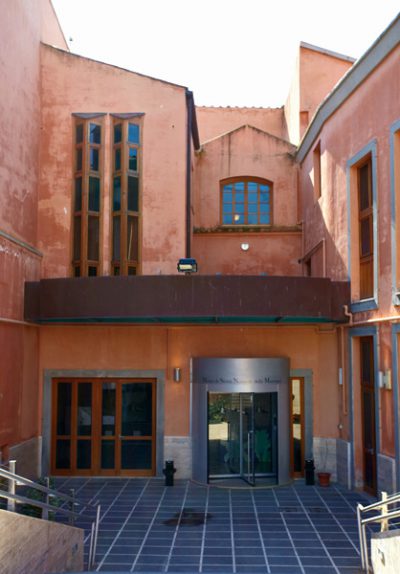
The entrance to the Natural History Museum of Maremma
The museum building is made up of two parts: one between strada Corsini and via dell’Unione, dating back to the 19th century, and one between strada Corsini and piazza della Palma, which is from the 20th century.
The natural history museum is set up on three floors and is made up of twelve exhibition rooms, which are divided into two large sections: the one dedicated to the “earth sciences” and the one dedicated to the “sciences of life“.
The first focuses on the geological and paleontological evolution of Grosseto and the Maremma, with numerous samples of minerals, rocks and fossils. It is divided into two main rooms: the minerals and rocks room and the paleontology room.
The second room, dedicated to paleontology, exhibits fossil samples from the Maremma area, arranged according to a chronological sequence, from Jurassic to Pleistocene. The oreopithecus bambolii, symbol of the museum, has been reconstructed in a natural-sized three-dimensional model based on the skeleton which was found in Baccinello in 1958: an entire diorama has been dedicated to the animal with a reconstruction of the contemporary flora and fauna. Among the various exhibitions, flints and artifacts documenting prehistoric cultures in Maremma.
The visitor reaches the next section by crossing a corridor whose dark wall is animated by fluorescent drawings representing the tree of living diversity, ordered in terms of complexity, from prokaryotes to mammals. However, this is not an evolutionary tree. The “Life sciences” section displays samples and models set in their chosen habitats, starting with the large water room, then that of the coastal and hilly environments and the room of the high-hilly and mountain environments, as well as spaces for didactic activities and a reconstruction of royal scale of a cave.
• The Biancane nature park is a natural area near the center of Monterotondo Marittimo (GR) where the “biancane” characteristics are located, which represent one of the many sites where geothermal energy strongly characterizes the landscape on the border between the provinces of Pisa and Grosseto. In fact, there is the presence of different types of geothermal events such as geysers, steam leaks from the ground, potholes and fumaroles and geothermal wells.
The name derives from the white color of the rocks which characterizes the whole landscape; in fact, the hydrogen sulphide emissions cause a chemical reaction with the limestone, transforming it into plaster.
The Biancane with its Lagoni represent one of the areas of competence of the Archaeological Technological Park of the Grosseto Metalliferous Hills.
•Maremma natural park, regional protected area Established in 1975, it is one of the most important parks in Tuscany and takes up part of the municipal area of Grosseto south of the hamlets of Rispescia and Alberese. In 1992 he was awarded the European Diploma of Protected Areas. It includes some sites of community interest including the trappola marsh, Bocca d’Ombrone and the Granducale pine forest.
Marina di Grosseto
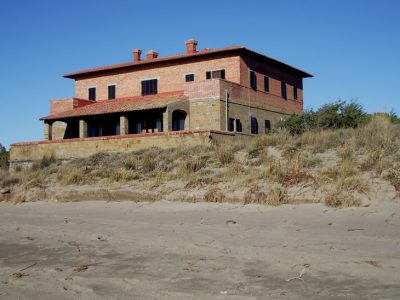
Forte delle Marze
A seaside village in the municipality of Grosseto, it was born in 1793 with the completion of the tower commissioned by Ferdinand III of Tuscany. Previously known as San Rocco, a fishing village with its sedge huts and a few masonry houses and characteristic shacks, it has transformed into the current locality where villas, modern palaces, restaurants, banks have created a dimension that is now a town. It is known for its hilly hinterland full of Mediterranean scrub and for the wide beaches overlooking the sea Tyrrhenian, with a vast pine forest , known as Pineta del Tombolo, which extends from Punta Ala to the Uccellina Mountains.
The town center develops at the mouth of the San Rocco emissary canal, on the border with the Maremma Natural Park, not far from Bocca d’Ombrone, the mouth of the Ombrone river.
•Forte delle Marze, located on the coastal stretch that goes from Marina di Grosseto to Castiglione della Pescaia, it is a fortified structure built in XVIII century on the site of a previous watchtower, and performed watching functions, defense and salt collection. Subsequently transformed into a luxurious villa, it is still privately owned today.
•Festa di San Rocco: patronal feast which is also the main tourist event and attraction of the bathing season . Every August 16th, before midnight, the festivities reach their suggestive climax with a parade of floats allegorical for the walk in center, and with fireworks launched from the seashore that illuminate the beach crowded with spectators.
Furthermore, Marina di Grosseto is connected to the city with the Grosseto-Marina di Grosseto cycle path, to Principina a Mare with the Marina di Grosseto-Principina a Mare cycle path, and to Castiglione della Pescaia with the Marina di Grosseto-Castiglione della Pescaia cycle path.



